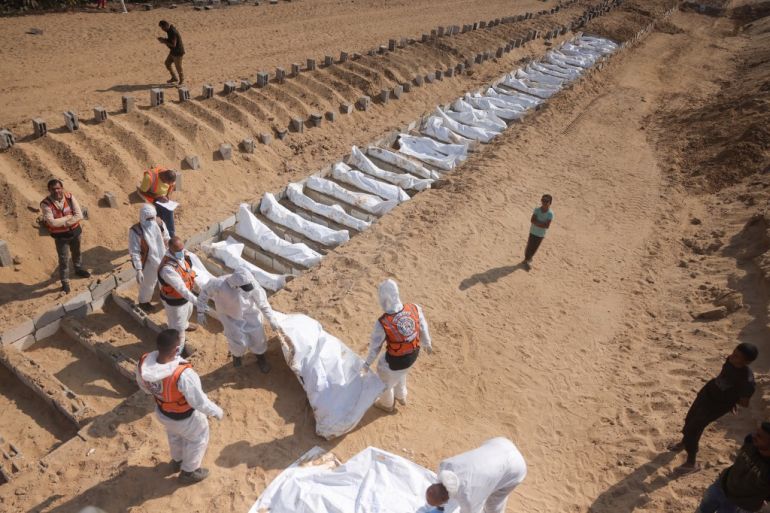Israeli drone strike kills two in Gaza as ceasefire violations mount
Hamas condemns Israel’s “daily and continuous violations” since a truce came into effect last month.

By Elis Gjevori
Published On 10 Nov 202510 Nov 2025
Save
At least two people including a child have been killed in an Israeli drone strike east of Khan Younis in southern Gaza, according to Al Jazeera reporters in the besieged Palestinian territory.
Hamas condemned Israel’s “daily and continuous violations” since a truce came into effect last month, accusing it of maintaining a campaign of bombardments and demolitions across the besieged enclave.
Recommended Stories
list of 3 itemsend of list
In a statement published on Telegram on Monday, the group said Israeli attacks had killed 271 people, over 90 percent of them civilians, and wounded 622 more since the ceasefire took effect on October 10.
The Israeli military said the Palestinians killed on Monday posed “an immediate threat” to its forces.
Israeli forces have also been systematically destroying homes inside the so-called “yellow line”, a temporary withdrawal boundary agreed in the ceasefire.
Al Jazeera’s correspondents on the ground have said demolition operations in eastern Khan Younis have intensified. “Every two-storey building or house is being targeted,” said Hamdan Radwan, mayor of Bani Suheila, the largest municipality in the area.
Al Jazeera correspondents have confirmed Israeli forces are blowing up residential blocks in central Gaza as well. Satellite images and field footage show large swathes of neighbourhoods reduced to rubble.

Israel continues to restrict aid deliveries
Israel also continues to restrict aid deliveries to Gaza, violating one of the key terms of the ceasefire. Hamas said Israel had refused to allow at least 600 aid trucks daily, including 50 carrying fuel, despite the agreement.
Advertisement
On Sunday, only 270 trucks entered Gaza through the Karem Abu Salem (known in Israel as Kerem Shalom) and al-Karara (Kissufuim) crossings.
According to Al Jazeera’s reporters, the deliveries included 126 trucks of humanitarian aid, 127 carrying commercial goods, 10 with fuel and seven transporting cooking gas.
While aid flow has increased since the ceasefire began, Palestinians across Gaza continue to suffer from extreme shortages of food, medicine, clean water and essential goods.
Many remain homeless, with entire neighbourhoods destroyed by nearly two years of relentless Israeli bombardment.
The United Nations Relief and Works Agency for Palestine Refugees (UNRWA) says between 500 and 600 trucks of supplies are needed daily to meet Gaza’s most basic needs. But Israel’s restrictions have left the agency struggling to deliver aid.
John Whyte, UNRWA’s senior deputy director for Gaza operations, told Irish news outlet The Journal that Israel has barred the agency’s vehicles from entering altogether.
“They just won’t let anything that’s owned by UNRWA go in,” Whyte said. “They’re requiring us to hand our supplies to other agencies and remove the UNRWA logo before they can cross. It’s creating enormous logistical delays.”
Israel outlawed UNRWA last year, with the ban taking effect in January, cutting off a critical lifeline for Gaza’s displaced population.
Reporting from Deir el-Balah, Al Jazeera’s Hind Khoudary noted that Palestinians were promised 600 trucks of aid daily as part of the ceasefire. “We’ve been monitoring the situation, and the majority of trucks entering are non-essential commercial ones,” she said. “According to the UN and Reuters, only around 200 trucks of humanitarian aid are entering each day.”
Khoudary added that in northern Gaza, where many displaced families are returning, the UN has reported no direct aid entry for 75 days. “People told us they go to bed hungry. They queue for hours for water and can’t afford meat or eggs,” she said.
Israel hands over Palestinian bodies
As part of the ceasefire’s body exchange arrangement, Israel on Monday handed over the remains of 15 Palestinians to authorities in Gaza. A medical source told Wafa news agency that the Red Cross transferred the bodies to Nasser Hospital in Khan Younis.
It was the 12th such exchange under the deal, bringing the total number of bodies returned to 315. Only 89 have been identified so far due to decomposition and a lack of proper equipment in Gaza. Wafa reported that most of the recovered bodies showed signs of torture.
Advertisement
Hamas said it had fulfilled its obligations under the agreement, handing over 20 living captives within 72 hours “despite extremely difficult field conditions”. It said it had retrieved 24 of 28 bodies and shared coordinates for others located in areas under Israeli control.
Meanwhile, the World Health Organization (WHO) announced that al-Kheir Hospital in Khan Younis has resumed operations after months of closure due to Israeli attacks. The WHO said it helped rehabilitate the facility by restoring power, sanitation and water systems, and providing medical equipment.
A new 20-bed nutrition stabilisation centre has also opened in the hospital, bringing the total number of such centres across Gaza to eight. These facilities treat children suffering from severe malnutrition complicated by infections and dehydration, conditions that have become widespread amid the continuing Israeli blockade.

